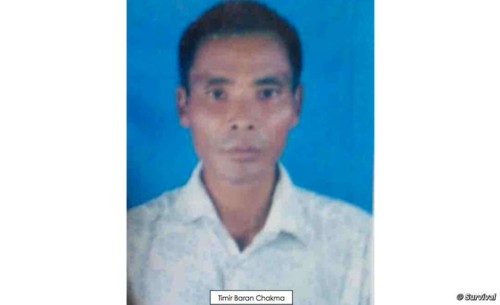| CHT |
| Background |
| Bengali Settlers |
| Armed Resistance |
| Massacres |
| Genocide |
| Religious Persecution |
| Rapes & Abductions |
| Chakma Refugees |
| CHT Treaty |
| Foreign Aid |

|
On August 10, 2014 Bangladesh army torture and murder Timir Baran Chakma (52) in custody in Matiranga, Khagrachari district. The alleged torture took place in Washu Rubber Plantation in Indramuni Para, Matiranga Upazila, Khagrachari Hill District in the Chittagong Hill Tracts (CHT) of Bangladesh. |
Bangladesh army murders an indigenous Chakma Buddhist in Matiranga
On August 10, 2014 Bangladesh army torture and murder Timir Baran Chakma (52) in custody in Matiranga, Khagrachari district. The alleged torture took place in Washu Rubber Plantation in Indramuni Para, Matiranga Upazila, Khagrachari Hill District in the Chittagong Hill Tracts (CHT) of Bangladesh.
Timir Baran Chakma was a member of the Shanti Bahini, the armed wing of the Jana Sanghati Samiti (JSS), which waged an insurgency for autonomy in the CHT during the 1970s. The insurgency was brought to an end through the 1997 CHT ‘Peace’ Accord that was signed by the JSS and the Government of Bangladesh. After the signing of the Accord he returned to his village and started working as a farmer.
On 10 August 2014 at 6:30 am, Bangladesh army arrested Timir Baran Chakma along with 3 other indigenous people on suspicion of possessing of firearms from Indramuni Para village in Matiranga, Khagrachari district. The three others were Real Tripura, Nishimoni Chakma and Umor Kanti Chakma.
On 10 August Sergeant Mohammad Rezaul Karim filed a deposition saying that he, along with 9 other Bangladesh army officers of various ranks received information about possession of illegal firearms during a special raid of the area and took 4 indigenous people into custody. The operation was led by Captain Kauser Badal of Matiranga Military Zone. Others who were involved are
- Sergeant Md. Rezaul Karim (No- 1215912)
- Sergeant Md. Yakub Ali (No- 1217174)
- Lt. Corporal Md. Abul Hossain (No-1223328)
- Lt. Corporal Md. Ali Ashraf (No- 1225167)
- Lt. Corporal Md. Mofazzal (No- 1224659)
- Soldier Md. Tuhin (No- 1234643)
- Soldier Md. Mithu Biswas (No- 1231366)
- Soldier Md. Shahin (No- 1234825)
- Soldier Md. Narul Islam (No- 1232899)
- Soldier Md. Enamul (No- 123107).
After Timir Baran allegedly admitted to possessing firearms, he took the army officers to the area in a deep jungle where he had "hidden" the weapons. According to the deposition, when the army officers were recovering the weapons, Timir Baran tried to escape, hit a tree and fell down a hill where he received injuries to different parts of his body. He was also having breathing difficulties during this time and the military officers admitted him to Matiranga Health Complex, where he later died.
According to the JSS (MN Larma) press statement Bangladesh army and local administration hurriedly cremated Timir Baran’s body. His body was cremated on the night of 10 August at around 11 PM in Mahajanpara cremation grounds near Muslimpara. An unofficial curfew was enforced in the area at that time and local villagers were asked not to come out of their homes. The cremation was carried out in a cricket pitch inside the cremation grounds where there is no grass instead of the actual cremation area where there is grass. It is believed this was done in order to not leave any evidence of burnt grass there.
It may also be mentioned that cremations are a religious and social ceremony for Chakma communities so it is not clear why military authorities carried out this ceremony without the presence of the families and in such a hurry in the dead of the night on 10 August 2014. The military authorities at that time also declared that the identity of the person being cremated was not known to them which is contrary to the events that led up to the cremation.
The evidence presented gives a strong indication that Bangladesh army tortured Timir Baran Chakma. Bangladesh army hurriedly carried out cremation in order to cover up the evidence of torture marks on his body.
No criminal case was filed either by Timir Baran’s family or by his party officials as they feel their life would be under threat if they filed a case against someone in the Bangladesh army. The only case that was filed in connection to this death was the FIR filed by Sergeant Mohammad Yakub Ali who was one of the military officers involved with taking Timir Baran into custody. No arrests have been made in connection to this death.
In both the deposition and the FIR there is lengthy details of firearms that were allegedly recovered from Timir Baran, however, no details were available about the physical condition of his body during his death. In the deposition filed on 10 August 2014, it is mentioned that Timir Baran died from breathing problems but this is not corroborated by a medical examiner’s report. Bangladesh army did not make an official statement about the circumstances surrounding his death.
Sources:
International for Indigenous Work Group Affairs (IWGIA)comments powered by Disqus